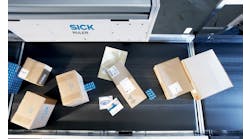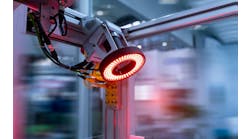"The monthly VDMA order intake and turnover statistics show that the order books of the machine vision industry are full to the brim. The demand for machine vision components and systems remain very high, however, companies are struggling to keep up with production due to the shortage of materials especially electronic components and therefore are having to reduce their current production plans," says Mark Williamson, chairman of the Board of VDMA Machine Vision, on the occasion of the opening of the VISION 2021 trade fair. “VDMA Machine Vision is therefore sticking to its forecast of 7% growth in turnover for the European industry for the current year and expect further growth of 7% percent in 2022, according to the latest VDMA survey."
In 2020, the turnover of the European machine vision industry fell by 4% compared to the previous year due to COVID-19. This was mainly due to weakening demand in Europe and the global automotive, pharmaceutical, metal, plastics and rubber industries. Nevertheless, this was a very good result compared to other areas of the mechanical engineering industry. The growth prospects for the coming years remain strong with the trend toward "seeing machines" continuing for a number of years. Machine vision has established itself as a key component in the global race towards automation.
Non-industrial applications on the rise
Machine vision is constantly conquering new sales markets and fields of application. In 2020, the share of the European machine vision industry's turnover in sectors outside the factory floor, such as medical technology, security, agriculture, intelligent traffic systems as well as retail, was already 35%, and turnover there grew by 9%. Embedded vision in combination with artificial intelligence will set new growth stimuli.
In 2020, the European machine vision industry's turnover with the electronics industry (excluding semiconductors) increased by 20% and turnover with the semiconductor industry growing by 10%. Turnover within the automotive industry, otherwise the strongest customer of the machine vision industry, fell by 13%. The share of total turnover thus only accounted for 16%. Turnover within the food and beverage industry stagnated.
Asia as a growth driver
Europe remains an important sales market. 52% of the turnover of the European machine vision industry was achieved in Europe in 2020, 6% less than in the previous year while exports to Asia increased by 3%. Turnover in China grew by 10% and exports to America increased by 5%.
Record sales of cameras
Sales of machine vision components fell by 2% overall in the Covid-19-year, 2020. Industrial cameras were the exception with a share of 27% of the total turnover of the European machine vision industry and recorded a 4% increase in turnover. The turnover of machine vision systems, on the other hand, fell by 3%.
Chip shortage burdens the industry
Many companies are struggling with increasing material and supply bottlenecks. In the VDMA flash survey at the beginning of September, 81% of mechanical engineering companies from all branches mentioned noticeable or serious impairments in their supply chains. Shortages of electronic components in particular have dramatically increased. Additional surveys among the membership of the VDMA Machine Vision sector group show the machine vision industry is not exempt from this challenge. There is virtually no company not suffering from the chip shortage including component manufacturers as well as system integrators with the situation worsening in the last three months and no improvement expected in the next three months.
As a result, companies in the machine vision industry are having to cut back on their production plans with delivery of products being delayed. Impairments are also being felt on the demand side, as customers and their customers are in turn affected by the shortage of materials stalling the entire value chain. Despite a multi-layered shortage of materials, in customer industries, the demand for machine vision is not affected. Machine vision remains in high demand not only in and around factories worldwide, but also in new areas and applications.



